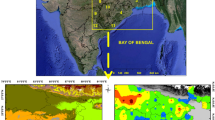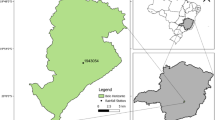Abstract
Micro rain radar (MRR-2) provides the measurement of the drop size distribution DSD with altitude and rain rates. In this paper, we show a new form of gamma drop size distribution (DSD) model. MRR-2 is based on the principle of Radar spectrum measurement of continuous-wave of frequency modulation. DSD measurements for the rain rates ~ 0–25 mm/h and the height from 150 to 2000 m during the south-west monsoon season for the period 2009 and 2010 are used in this study. From the variance of DSD (\(\sigma^{2}\)) and mass-weighted mean drop diameter as well as after the mathematical calculation, two parameters (\(\varLambda\) and µ) are obtained for the use of lower-order moments. Both the moments are utilized for the best suitable of gamma DSD. Measured DSD for the different rain rates and different altitudes below the melting layer height (~ 2–3 km) compared among the exponential, lognormal and gamma DSD model over Darjeeling in the Eastern Himalaya. The correlation between best fit measured DSD and gamma distribution indicate that they correlate well for both lower and higher order moments for the heights 150 m and 1050 m. Whereas they correlated only for higher order moments for the 450 m, 1500 m and 1950 m. Thus, it is found that the observed pattern of DSD agrees well to the gamma DSD model.










Similar content being viewed by others
References
Adimula, I. A., & Ajayi, G. O. (1996). Variations in raindrop size distribution and specific attenuation due to rain in Nigeria. Annales des télécommunications (pp. 87–93). Berlin: Springer.
Atlas, D., Srivastava, R. C., & Sekhon, R. S. (1973). Doppler radar characteristics of precipitation at vertical incidence. Reviews of Geophysics,11(1), 1–35.
Atlas, D., Ulbrich, C. W., & Meneghini, R. (1984). The multiparameter remote measurement of rainfall. Radio Science,19(1), 3–22.
Bringi, V. N., Chandrasekar, V., Hubbert, J., Gorgucci, E., Randeu, W. L., & Schoenhuber, M. (2003). Raindrop size distribution in different climatic regimes from disdrometer and dual-polarized radar analysis. Journal of the Atmospheric Sciences,60(2), 354–365.
Chandrasekar, V., & Bringi, V. N. (1987). Simulation of radar reflectivity and surface measurements of rainfall. Journal of Atmospheric and Oceanic Technology,4(3), 464–478.
Chu, Y. H., & Su, C. L. (2008). An investigation of the slope–shape relation for gamma raindrop size distribution. Journal of Applied Meteorology and Climatology,47(10), 2531–2544.
Feingold, G., & Levin, Z. (1986). The lognormal fit to raindrop spectra from frontal convective clouds in Israel. Journal of Climate and Applied Meteorology,25(10), 1346–1363.
Gunn, R., & Kinzer, G. D. (1949). The terminal velocity of fall for water droplets in stagnant air. Journal of Meteorology,6(4), 243–248.
Haddad, Z. S., Durden, S. L., & Im, E. (1996). Parameterizing the raindrop size distribution. Journal of Applied Meteorology,35(1), 3–13.
Haddad, Z. S., et al. (1997). A new parametrization of the rain drop size distribution. IEEE Transactions on Geoscience and Remote Sensing,35(3), 532–539.
Harikumar, R., Sampath, S., & Kumar, V. S. (2009). An empirical model for the variation of rain drop size distribution with rain rate at a few locations in southern India. Advances in Space Research,43(5), 837–844.
Islam, M. R., Rahman, T., Khan, S., Khalifa, O., & Rashid, M. M. (2004). The rain attenuation prediction methods from 10 to 37 GHz microwave signals based on data measured in Malaysia. In: 3rd International Conference on Electrical, pp. 394–397.
Jash, D., Resmi, E. A., Unnikrishnan, C. K., Sumesh, R. K., Sreekanth, T. S., Sukumar, N., et al. (2019). Variation in rain drop size distribution and rain integral parameters during southwest monsoon over a tropical station: An inter-comparison of disdrometer and Micro Rain Radar. Atmospheric Research,217, 24–36.
Jassal, B. S., Vidyarthi, A., Gowri, R., & Shukla, A. K. (2011). Modeling of rain drop size distribution for a tropical hot semi-arid site in India. 92.40.
Joss, J., & Gori, E. G. (1978). Shapes of raindrop size distributions. Journal of Applied Meteorology,17(7), 1054–1061.
Joss, J., & Waldvogel, A. (1967). Ein spektrograph für niederschlagstropfen mit automatischer auswertung. Pure and Applied Geophysics,68(1), 240–246.
Kozu, T., & Nakamura, K. (1991). Rainfall parameter estimation from dual-radar measurements combining reflectivity profile and path-integrated attenuation. Journal of Atmospheric and Oceanic Technology,8(2), 259–270.
Maitra, A. (2000). Three-parameter raindrop size distribution modelling at a tropical location. Electronics Letters,36(10), 906–907.
Marshall, J. S. (1948). The distribution of raindrops with size. J. Meteor.,5, 165–166.
Marshall, J. S., & Palmer, W. M. K. (1948). The distribution of raindrops with size. Journal of meteorology,5(4), 165–166.
Mehta, S., Singh, S., Mitra, A., Ghosh, S. K., & Raha, S. (2019). Diurnal variation of the lower tropospheric water vapor observed using microwave radiometer over Darjeeling (27.05 N, 88.26 E). Journal of the Indian Society of Remote Sensing,47(4), 619–628.
Pontes, M. S., da Silva Mello, L., de Souza, R. S. L., & Miranda, E. C. B. (2005). Review of rain attenuation studies in tropical and equatorial regions in Brazil. In: Information, Communications and Signal Processing Fifth International Conference on IEEE, pp. 1097–1101.
Reddy, K. K., Kozu, T., Ohno, Y., Jain, A. R., & Rao, D. N. (2005). Estimation of vertical profiles of raindrop size distribution from the VHF wind pro filer radar Doppler spectra. 92.60. Jq; 92.60. Ry.
Sauvageot, H., & Lacaux, J. P. (1995). The shape of averaged drop size distributions. Journal of the Atmospheric Sciences,52(8), 1070–1083.
Smith, P. L. (2003). Raindrop size distributions: Exponential or gamma—Does the difference matter? Journal of Applied Meteorology,42(7), 1031–1034.
Sumesh, R. K., Resmi, E. A., Unnikrishnan, C. K., Jash, D., Sreekanth, T. S., Resmi, M. M., et al. (2019). Microphysical aspects of tropical rainfall during Bright Band events at mid and high-altitude regions over Southern Western Ghats, India. Atmospheric Research,227, 178–197.
Takeuchi, D. M. (1978). Characterization of raindrop size distributions. In: Conference on Cloud Physics and Atmospheric Electricity, Issaquah, Wash, pp. 154–161.
Tokay, A., & Short, D. A. (1996). Evidence from tropical raindrop spectra of the origin of rain from stratiform versus convective clouds. Journal of Applied Meteorology,35(3), 355–371.
Torres, D. S., Porrà, J. M., & Creutin, J. D. (1994). A general formulation for raindrop size distribution. Journal of Applied Meteorology,33(12), 1494–1502.
Ulbrich, C. W. (1983). Natural variations in the analytical form of the raindrop size distribution. Journal of Climate and Applied Meteorology,22(10), 1764–1775.
Ulbrich, C. W., & Atlas, D. (1984). Assessment of the contribution of differential polarization to improved rainfall measurements. Radio Science,19(1), 49–57.
Ulbrich, C. W., & Atlas, D. (1998). Rainfall microphysics and radar properties: Analysis methods for drop size spectra. Journal of Applied Meteorology,37(9), 912–923.
Vidyarthi, A., Jassal, B. S., & Gowri, R. (2011). Modeling of rain drop-size distribution for Indian region. In: Microwave Technology & Computational Electromagnetics (ICMTCE), 2011 IEEE International Conference on IEEE, pp. 350–353.
Vidyarthi, A., Jassal, B. S., Gowri, R., & Shukla, A. K. (2012). Regional variability of rain drop size distribution model in India. Progress In Electromagnetics Research,34, 123–135.
Waldvogel, A. (1974). The N 0 jump of raindrop spectra. Journal of the Atmospheric Sciences,31(4), 1067–1078.
White, A. B., Gottas, D. J., Strem, E. T., Ralph, F. M., & Neiman, P. J. (2002). An automated brightband height detection algorithm for use with Doppler radar spectral moments. Journal of Atmospheric and Oceanic Technology,19(5), 687–697.
Williams, C. R. (2002). Simultaneous ambient air motion and raindrop size distributions retrieved from UHF vertical incident profiler observations. Radio Science,37(2), 1–22.
Williams, C. R., & Gage, K. S. (2009). Raindrop size distribution variability estimated using ensemble statistics. In: Annales geophysicae: atmospheres, hydrospheres and space sciences, Vol. 27, No. 2, p. 555.
Willis, P. T., & Tattelman, P. (1989). Drop-size distributions associated with intense rainfall. Journal of Applied Meteorology,28(1), 3–15.
Acknowledgements
This work is fully supported by Intensification of Research in High Priority Area (IRHPA), Department of Science and Technology (DST), Govt. of India. We thank technical team members of the IRHPA project at Bose Institute for taking the MRR observations. First author (SM) is thankful to Department of Science and Technology, Govt. of India for providing the fellowship under IRHPA project. Authors thank to SRM HPCC for processing the Global 30-arc-second topography data.
Author information
Authors and Affiliations
Corresponding author
Additional information
Publisher's Note
Springer Nature remains neutral with regard to jurisdictional claims in published maps and institutional affiliations.
Rights and permissions
About this article
Cite this article
Mehta, S., Singh, S., Mitra, A. et al. Modeling of Raindrop Size Distribution Observed Using Micro Rain Radar Over Darjeeling (27.05oN, 88.26oE): An Eastern Himalayan Region. Pure Appl. Geophys. 177, 2959–2976 (2020). https://doi.org/10.1007/s00024-019-02370-6
Received:
Revised:
Accepted:
Published:
Issue Date:
DOI: https://doi.org/10.1007/s00024-019-02370-6




